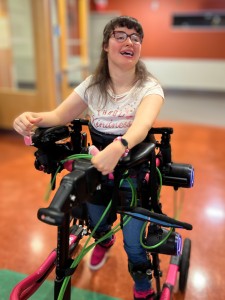How technology helps kids and youth with disabilities move more
January 2, 2025 | News

Kids Brain Health Network-funded researchers study wearable robotics and brain-computer interface technology that allow kids and youth with neurodevelopmental disabilities to play.
Alex is a fitness enthusiast living with cerebral palsy. Some of the many activities she enjoys are rock climbing, horseback riding and water skiing. “My motto is ‘I can do it,’” says Alex, who is also a Kinesiology student at Mount Royal University. “I want to inspire people and help them become more active.”
She shared her journey with the Kids Brain Health Network (KBHN) members at a team retreat in Calgary. During her presentation, she described how adaptations help her stay active and highlighted her participation in a research study at the Pediatric Onset of Neuromotor Impairment Lab (PONI Lab).
“Our lab is interested in understanding the impact of technology, such as mobility aids, in addressing the barriers faced by patients with physical disabilities caused by neurological conditions,” said Dr. Elizabeth Condliffe, Lead Researcher of PONI Lab and a recipient of the KBHN Early Career Investigator & Mentorship Award.
A key moment is when Alex showed how to use her mobility aid developed by Trexo. The robotic walker supports leg movements, allowing children and youth with severe motor impairments to walk. The speed, joint angles and level of support are controllable with a tablet attached to the machine.

Alex, who lives with spastic cerebral palsy that makes her muscles weak, stiff and difficult to control, previously managed 30 steps with a manual walker before feeling fatigued. Since using the robotic walker, she now easily achieves over 4,000 steps. The goal of PONI Lab’s research is to understand the long-term benefits of technologies, like Alex’s robotic walker, for children and youth with mobility challenges.
“We need better approaches to identify the right interventions for people with lifelong disabilities and to do that, the input of families and transdisciplinary researchers is vital,” said Dr. Condliffe, Assistant Professor in the Department of Clinical Neurosciences at the University of Calgary.
Controlling mobility devices with brain activity
That same day, the KBHN team visited BCI4Kids Calgary, led by Dr. Adam Kirton. The program focuses on how children with neurodevelopmental disabilities can harness brain-computer interface (BCI) technology to control mobility apps or devices with their minds.
One of the families partnering with BCI4Kids Calgary is Thomas and his mom, Nina. He is a twelve-year-old boy living with quadriplegic cerebral palsy who uses the technology that monitors his brain activity and tells the electronic wheelchair if he wants to move forward or turn.
“While BCI is widely used in adult patients, our focus is on children with neurological disabilities, investigating how and why this technology works for them,” said Dr. Kirton, Pediatric Neurologist at the Alberta Children’s Hospital. In parallel with the technical studies, BCI4Kids is working to transition BCI from research settings to clinics, homes, and communities.
KBHN funded the BCI-Move program to conduct a preliminary study with nine children who use BCI to activate a power wheelchair.
 Two members of the BCI4Kids team, Dr. Daniel Comaduran Marquez and Daniella Bourque, shared their work on developing a BCI-controlled Boccia ramp for children with severe physical disabilities.
Two members of the BCI4Kids team, Dr. Daniel Comaduran Marquez and Daniella Bourque, shared their work on developing a BCI-controlled Boccia ramp for children with severe physical disabilities.
“Play and sports are vital for child development,” said Dr. Comaduran Marquez, Postdoctoral Associate at the University of Calgary. “Our project enables children to participate in a Paralympic sport for the first time, opening doors to inclusion and a sense of belonging.”
Dr. Kirton explained that BCI4Kids Calgary has collaborated with engagement experts to ensure the active involvement of families with lived experience throughout the research process. “We have partnered with children, families and caregivers from the beginning, and they continue to inform our work at every stage,” he said.
Transforming innovation into action
The KBHN team retreat in Calgary was not only about strategic planning on scaling innovations but also about seeing research in action. The day provided an opportunity for the team to witness and reflect on the impact of discoveries and their translation into the lives of children.
“We are honoured to witness the incredible work being done by KBHN-funded researchers and are reminded of the importance of what we do,” said KBHN Chief Scientist Dr. Jennifer Zwicker.
KBHN continues to scale, spread, and implement solutions for kids with neurodevelopmental disabilities through collaboration and support from the Strategic Science Fund. In delivering on its mission, KBHN is advancing federal responsibilities and priorities aimed at building a healthier future for all kids.